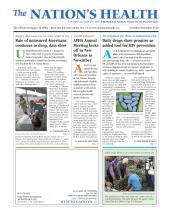Study: Direct mail marketing has effect on young smokers
Tobacco direct mail marketing promotes and sustains smoking behaviors, according to a study of Midwestern adults published online in September by APHA’s American Journal of Public Health.
Studying information from more than 2,600 young adults — defined as having a mean age of 24 — in the Midwest in 2010 to 2012, researchers found that 13 percent of those surveyed received tobacco direct mail materials over the previous six months. The materials included coupons for cigarettes and other tobacco products. Among nonsmokers and ex-smokers, receiving coupons was associated with becoming a current smoker by the time researchers followed up with survey participants. Among smokers, receiving promotional materials was associated with a lower likelihood of quitting smoking when researchers followed up.
The researchers, who were affiliated with the National Institute on Minority Health and Health Disparities Division of Intramural Research and University of Minnesota’s Division of Epidemiology and Community Health, suggested that because of their findings, direct mail marketing of tobacco-related materials should be regulated, as it might reduce prevalence of smoking among young adults.
US teen birth rate drops by more than half
The U.S. teen birth rate fell 57 percent between 1991 and 2013, according to new data from the National Center for Health Statistics.
The data, which were published in August in National Vital Statistics Reports, mean the current teen birth rate is less than one-third of what it was in 1957, when teen births reached their peak. Between 1991 and 2012, teen births declined among all racial and ethnic groups, with the largest declines among black teens, and decreased in every state as well. Overall, the decline translates to about 4 million fewer teen births. The study attributed the significant decline to a number of behavioral changes, such as increases in contraception use and less sexual activity among young people.
The study also found that the birth rate among the youngest girls — those ages 10-14 — fell to its lowest level ever in 2013. Since 1991, birth rates among teens ages 15-17 declined by 68 percent, while the birth rate among those ages 18-19 deceased 50 percent. Teen births come with considerable costs as well, estimated at $9.4 billion in 2010 alone. However, the recent declines are estimated to have saved the U.S. $12 billion that same year.
The study notes that despite significant progress, the U.S. teen birthrate still remains higher than rates in most developed countries.
For more information, visit www.cdc.gov/nchs/products/nvsr.htm.
Higher income linked to healthier eating
The U.S. income-related nutrition gap grew between 1999 and 2010, according to new research that examines the economic challenge of sustaining a healthy diet.
Published in September in JAMA Internal Medicine, the study found that people with higher socioeconomic status had healthier diets than people with lower socioeconomic status. The income-related differences were likely associated with healthier foods costing more as well as limited access to stores that sell nutritious foods in low-income neighborhoods.
The study reported that among racial and ethnic groups, Mexican-Americans had the healthiest diets, while blacks had the least healthy diets. Overall, women generally had better diets than men. Researchers hypothesized that the healthier eating among Mexican-Americans may be due to food tradition and culture, while poorer diets among blacks was linked to lower income and education. The study also found that dietary quality was the poorest and improved the slowest among people who had 12 years or less of formal education.
However, the study, which was based on data from more than 29,000 adults participating in the 1999-2010 National Health and Nutrition Examination Surveys, also found that Americans’ dietary quality has improved overall, with much of the gains associated with reduced consumption of trans fat.
“The overall improvement in diet quality is encouraging, but the widening gap related to income and education presents a serious challenge to our society as a whole,” said study author Walter Willett, MD, chair of the Department of Nutrition at Harvard School of Public Health.
APHA urges EPA to improve agricultural worker protections
APHA offered its congratulations to Environmental Protection Agency Administrator Gina McCarthy for the agency’s efforts to protect people working in agriculture.
In an Aug. 14 letter, Executive Director Georges Benjamin, MD, called the EPA’s proposed revisions to the Worker Protection Standard a good way to improve occupational health and safety for thousands of people, as well as save more than $250 billion each year on occupational illness and injury.
Benjamin included in his letter areas of the rule APHA strongly supports, as well as areas of the rule that could be improved further, including better training on pesticide exposure, an increased minimum age limit for pesticide handling, better hazard communication and information and preparedness for clinicians.
Comments on the standard’s revision closed on Aug. 18.
APHA offers comments on transportation issues
APHA has called on two national transportation authorities to offer better policy to improve the health and lives of millions of Americans.
In a Sept. 3 letter spearheaded by the Partnership for Active Transportation, APHA offered the U.S. Department of Transportation and Federal Highway Administration both praise and suggestions for improvements on the Statewide and Nonmetropolitan Transportation Planning and Metropolitan Transportation Planning regulations currently under review.
APHA highlighted the importance of creating infrastructure that makes it safe and convenient to walk or bicycle as part of daily behavior, and noted that increased motorized transportation can increase air pollution, which has negative health effects on children.
“Health also should be integrated into the planning process,” the letter suggested.
- Copyright The Nation’s Health, American Public Health Association









